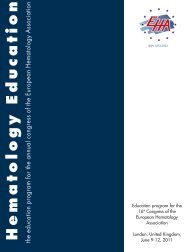hematology education - European Hematology Association
hematology education - European Hematology Association
hematology education - European Hematology Association
Create successful ePaper yourself
Turn your PDF publications into a flip-book with our unique Google optimized e-Paper software.
M. Cazzola<br />
L. Malcovati<br />
Department of <strong>Hematology</strong><br />
Oncology, University of Pavia<br />
Medical School, Pavia, Italy<br />
<strong>Hematology</strong> Education:<br />
the <strong>education</strong> program<br />
for the annual congress of the<br />
<strong>European</strong> <strong>Hematology</strong> <strong>Association</strong><br />
2009;3:181-187<br />
Myelodysplastic syndromes<br />
Risk-adapted treatment of myelodysplastic syndromes<br />
M yelodysplastic<br />
syndromes (MDSs)<br />
are usually characterized by clonal<br />
proliferation of hematopoietic<br />
cells, which partly retain their capacity to<br />
differentiate and maturate, but do so in an<br />
inefficient manner. 1 The bone marrow is<br />
generally hypercellular while peripheral<br />
blood cells are variably reduced (cytopenia),<br />
and several morphological abnormalities<br />
are observed in these two compartments.<br />
2 In addition, clones of hematopoietic<br />
cells carrying non-random cytogenetic<br />
abnormalities are typically found in these<br />
disorders. 3 With time, there is a progressive<br />
impairment in the capacity of hematopoietic<br />
cells to differentiate and maturate; blast<br />
cells may appear in the bone marrow and<br />
peripheral blood, and there is an increasingly<br />
high risk of evolution to overt acute<br />
myeloid leukemia (AML). The basic components<br />
of the definition of MDS are clonality,<br />
ineffective hematopoiesis and preleukemic<br />
nature. These features, however,<br />
A B S T R A C T<br />
Myelodysplastic syndromes (MDS) are usually characterized by clonal proliferation of hematopoietic<br />
cells, which partly retain their capacity to differentiate and maturate, but do so in an inefficient<br />
manner. Their clinical heterogeneity is best illustrated by the observation that these disorders range<br />
from indolent conditions with a near-normal life expectancy to forms approaching acute myeloid<br />
leukemia (AML). A risk-adapted treatment strategy is mandatory for conditions showing a so highly<br />
variable clinical course, and definition of the individual risk has been based so far on the use of prognostic<br />
scoring systems. We have developed a prognostic model that accounts for the WHO categories,<br />
cytogenetics and transfusion dependency. This WHO classification-based prognostic scoring system<br />
(WPSS) is able to classify patients into five risk groups showing different survivals and probabilities of<br />
leukemic evolution. WPSS predicts survival and leukemia progression at any time during follow-up,<br />
and may therefore be used for implementing risk-adapted treatment strategies. The approach to a<br />
patient with myelodysplastic syndrome should always begin with a period of observation, with<br />
sequential peripheral blood counts – and sometimes bone marrow examinations – to assess the rate<br />
of progression, if any. Several therapeutic tools have been proposed in the last decades but only few<br />
survived the evidence-based criteria of efficacy. Patients with very low WPSS risk do not need any<br />
treatment and can be just followed regularly. Transfusion dependent patients with low WPSS risk can<br />
be treated with recombinant human erythropoietin. Responsive patients are mainly those with early<br />
disease, inadequate endogenous erythropoietin production and low need for blood transfusion.<br />
Transfusion-dependent patients with myelodysplastic syndrome associated with del(5q) may respond<br />
to lenalidomide with cytogenetic remission and abolishment of transfusion requirement. However, in<br />
2008 the EMEA Committee for Medicinal Products for Human Use was of the opinion that the benefits<br />
of lenalidomide in the treatment of anemia of MDS with del(5q) did not outweigh its potential<br />
risks, and therefore the drug has not been approved for this use in Europe. A recent survival study comparing<br />
azacitidine versus conventional care showed that treatment with azacitidine increases overall<br />
survival in patients with higher-risk MDS. Thus, EMEA has recently approved azacitidine for the treatment<br />
of adult patients with high-risk myelodysplastic syndrome who are not eligible for allogeneic<br />
hematopoietic stem cell transplantation. The only treatment that can cure a patient with myelodysplastic<br />
syndrome is still allogeneic stem cell transplantation. It can be estimated that approximately<br />
one third of patients receiving an allogeneic transplantation are cured with this treatment, but only a<br />
minority of all MDS patients are eligible and have a donor.<br />
may be difficult to assess in a clinical setting,<br />
and – as stated in the World Health<br />
Organization (WHO) classification 4 –<br />
MDSs remain among the most challenging<br />
of the myeloid neoplasms for proper diagnosis<br />
and classification.<br />
Diagnosis and classification<br />
MDSs were defined and classified in 1982<br />
by the French American British (FAB)<br />
group. 5 In 2001, the WHO classification of<br />
myeloid neoplasms was developed. 6 This<br />
classification has been updated recently, 7<br />
and the 2008 WHO classification of myelodysplastic<br />
syndromes/neoplasms is reported<br />
in Table 1.<br />
The current diagnostic approach includes<br />
peripheral blood and bone marrow morphology<br />
(to evaluate abnormalities of peripheral<br />
blood cells and hematopoietic precursors),<br />
bone marrow biopsy (to assess<br />
marrow cellularity, fibrosis and topography),<br />
and cytogenetics (to identify non-ran-<br />
<strong>Hematology</strong> Education: the <strong>education</strong> program for the annual congress of the <strong>European</strong> <strong>Hematology</strong> <strong>Association</strong> | 2009; 3(1) | 181 |












